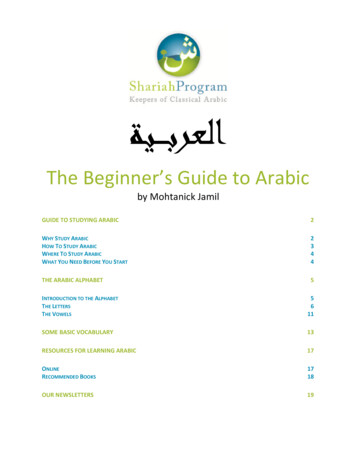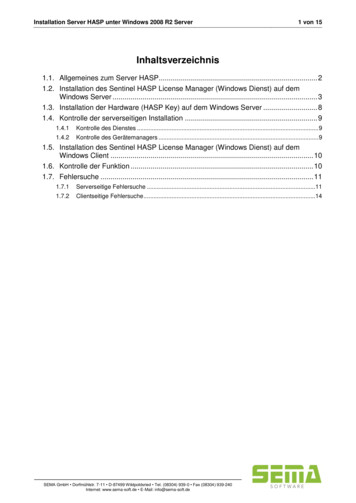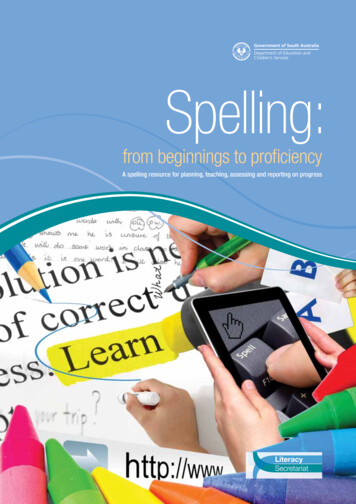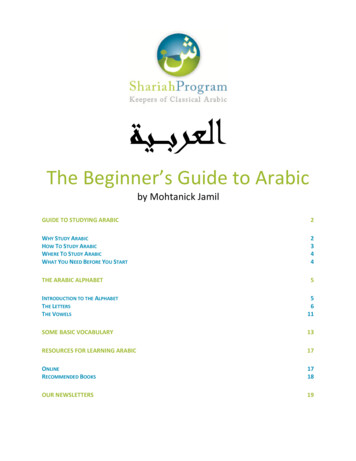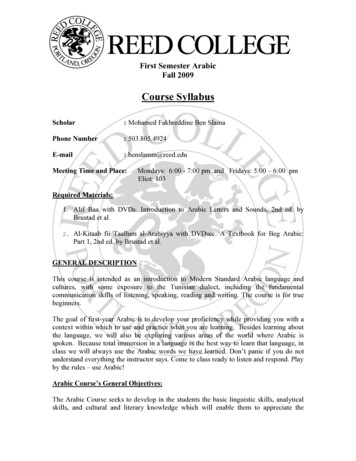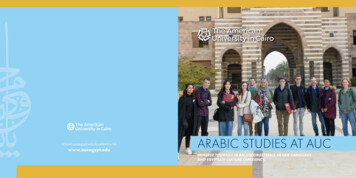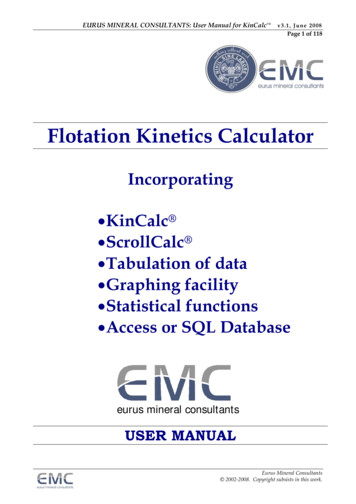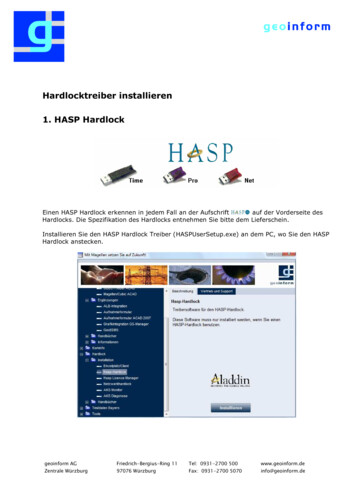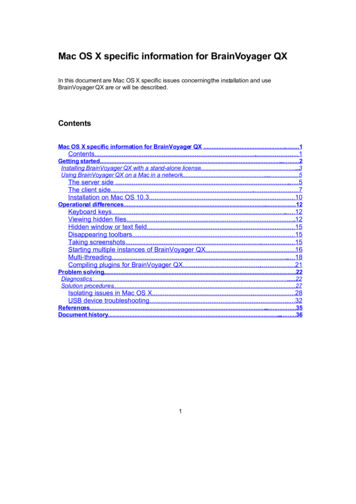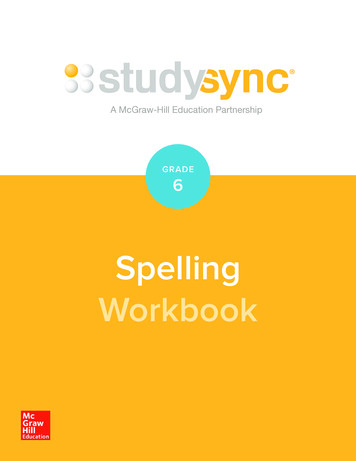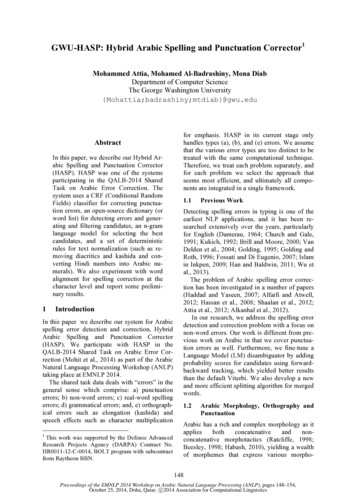
Transcription
GWU-HASP: Hybrid Arabic Spelling and Punctuation Corrector1Mohammed Attia, Mohamed Al-Badrashiny, Mona DiabDepartment of Computer ScienceThe George Washington ractIn this paper, we describe our Hybrid Arabic Spelling and Punctuation Corrector(HASP). HASP was one of the systemsparticipating in the QALB-2014 SharedTask on Arabic Error Correction. Thesystem uses a CRF (Conditional RandomFields) classifier for correcting punctuation errors, an open-source dictionary (orword list) for detecting errors and generating and filtering candidates, an n-gramlanguage model for selecting the bestcandidates, and a set of deterministicrules for text normalization (such as removing diacritics and kashida and converting Hindi numbers into Arabic numerals). We also experiment with wordalignment for spelling correction at thecharacter level and report some preliminary results.1IntroductionIn this paper1 we describe our system for Arabicspelling error detection and correction, HybridArabic Spelling and Punctuation Corrector(HASP). We participate with HASP in theQALB-2014 Shared Task on Arabic Error Correction (Mohit et al., 2014) as part of the ArabicNatural Language Processing Workshop (ANLP)taking place at EMNLP 2014.The shared task data deals with “errors” in thegeneral sense which comprise: a) punctuationerrors; b) non-word errors; c) real-word spellingerrors; d) grammatical errors; and, e) orthographical errors such as elongation (kashida) andspeech effects such as character multiplication1This work was supported by the Defense AdvancedResearch Projects Agency (DARPA) Contract No.HR0011-12-C-0014, BOLT program with subcontractfrom Raytheon BBN.for emphasis. HASP in its current stage onlyhandles types (a), (b), and (e) errors. We assumethat the various error types are too distinct to betreated with the same computational technique.Therefore, we treat each problem separately, andfor each problem we select the approach thatseems most efficient, and ultimately all components are integrated in a single framework.1.1Previous WorkDetecting spelling errors in typing is one of theearliest NLP applications, and it has been researched extensively over the years, particularlyfor English (Damerau, 1964; Church and Gale,1991; Kukich, 1992; Brill and Moore, 2000; VanDelden et al., 2004; Golding, 1995; Golding andRoth, 1996; Fossati and Di Eugenio, 2007; Islamin Inkpen, 2009; Han and Baldwin, 2011; Wu etal., 2013).The problem of Arabic spelling error correction has been investigated in a number of papers(Haddad and Yaseen, 2007; Alfaifi and Atwell,2012; Hassan et al., 2008; Shaalan et al., 2012;Attia et al., 2012; Alkanhal et al., 2012).In our research, we address the spelling errordetection and correction problem with a focus onnon-word errors. Our work is different from previous work on Arabic in that we cover punctuation errors as well. Furthermore, we fine-tune aLanguage Model (LM) disambiguator by addingprobability scores for candidates using forwardbackward tracking, which yielded better resultsthan the default Viterbi. We also develop a newand more efficient splitting algorithm for mergedwords.1.2Arabic Morphology, Orthography andPunctuationArabic has a rich and complex morphology as itappliesbothconcatenativeandnonconcatenative morphotactics (Ratcliffe, 1998;Beesley, 1998; Habash, 2010), yielding a wealthof morphemes that express various morpho-148Proceedings of the EMNLP 2014 Workshop on Arabic Natural Langauge Processing (ANLP), pages 148–154,October 25, 2014, Doha, Qatar. c 2014 Association for Computational Linguistics
syntactic features, such as tense, person, number,gender, voice and mood.Arabic has a large array of orthographic variations, leading to what is called ‘typographic errors’ or ‘orthographic variations’ (Buckwalter,2004a), and sometimes referred to as substandard spellings, or spelling soft errors. Theseerrors are basically related to the possible overlap between orthographically similar letters inthree categories: a) the various shapes of hamzahs ( ﺍا A2, ﺃأ , ﺇإ , ﺁآ , } ﺉئ , ' ء , ;)& ﺅؤ b) taa marboutah and haa ﺓة p, ﻩه h); and c) yaa and alifmaqsoura ( ﻱي y, ﻯى Y).Ancient Arabic manuscripts were written inscriptura continua, meaning running wordswithout punctuation marks. Punctuation markswere introduced to Arabic mainly through borrowing from European languages via translation(Alqinai, 2013). Although punctuation marks inArabic are gaining popularity and writers arebecoming more aware of their importance, yetmany writers still do not follow punctuation conventions as strictly and consistently as Englishwriters. For example, we investigated contemporaneous same sized tokenized (simple tokenization with separation of punctuation) English andModern Standard Arabic Gigaword editednewswire corpora, we found that 10% of the tokens in the English Gigaword corresponded topunctuation marks, compared to only 3% of thetokens in the Arabic counterpart.Word CountTotal ErrorsWord errorsPunc. errorsSplitAdd beforeDeleteEditMergeAdd .0353.515.970.010.08Table 1. Distribution Statistics on Error Types1.3Data AnalysisIn our work, we use the QALB corpus (Zaghouani et al. 2014), and the training and development set provided in the QALB shared task(Mohit et. al 2014). The shared task addresses alarge array of errors, and not just typical spelling2In this paper, we use the Buckwalter TransliterationScheme as described in www.qamus.com.errors. For instance, as Table 1 illustrates punctuation errors make up to 40% of all the errors inthe shared task.For further investigation, we annotated 1,100words from the development set for error types,and found that 85% of the word errors (excludingpunctuation marks) are typical spelling errors (ornon-word errors), while 15% are real-word errors, or lexical ambiguities (that is, they are validwords outside of their context), and they rangebetween dialectal words, grammatical errors,semantic errors, speech effects and elongation,examples shown in Table 2.Error rssemanticerrorsspeecheffects ﺑﻬﮭﺎﻱي bhAy‘by this’ [Syrian] ﻛﺒﻴﯿﺮ kbyr‘big.masc’ ﺁآﺗﻴﯿﻪﮫ tyh‘come to him’ ﺍاﻟﺮﺟﺎﺍاﺍاﺍاﻝل AlrjAAAAl ‘men’ ﺩدﻣـﺎء dm A'‘blood’ ﺑﻬﮭﺬﻩه bh*h‘by this’ [MSA] ﻛﺒﻴﯿﺮﺓة kbyrp‘big.fem’ ﺁآﺗﻴﯿﺔ typ‘coming’ ﺍاﻟﺮﺟﺎﻝل AlrjAl ‘men’ ﺩدﻣﺎء dmA'‘blood’elongationTable 2. Examples of real word errors2Our MethodologyDue to the complexity and variability of errors inthe shared task, we treat each problem individually and use different approaches that prove to bemost appropriate for each problem. We specifically address three subtypes of errors: orthographical errors; punctuation errors; and nonword errors.2.1Orthographical ErrorsThere are many instances in the shared task’sdata that can be treated using simple and straightforward conversion via regular expression replace rules. We estimate that these instancescover 10% of the non-punctuation errors in thedevelopment set. In HASP we use deterministicheuristic rules to normalize the text, includingthe following:1. Hindi numbers (٠۰١۱٢۲٣۳٤٥٦٧۷٨۸٩۹) are convertedinto Arabic numerals [0-9] (occurs 495 in thetraining data times);2. Speech effects are removed. For example, ﺍاﻟﺮﺟﺎﺍاﺍاﺍاﻝل AlrjAAAAl ‘men’ is converted to ﺍاﻟﺮﺟﺎﻝل AlrjAl. As a general rule letters repeated threetimes or more are reduced to one letter (715times);3. Elongation or kashida is removed. For example, ﺩدﻣــﺎء dm A' ‘blood’ is converted to149
ﺩدﻣﺎء dmA' (906 times);4. Special character U 06CC, the Farsi yeh: ﯼی is converted to U 0649, the visually similarArabic alif maqsoura ﻯى Y (293 times).2.2Punctuation ErrorsPunctuation errors constitute 40% of the errors inthe QALB Arabic data. It is worth noting that bycomparison, punctuation errors only constituted4% of the English data in CoNLL 2013 SharedTask on English Grammatical Error Correction(Ng et al., 2013) and were not evaluated or handled by any participant. In HASP, we focus on 6punctuation marks: comma, colon, semi-colon,exclamation mark, question mark and period.The ‘column’ file in the QALB shared task data comes preprocessed with the MADAMIRAmorphological analyzer version 04092014-1.0beta (Pasha et al., 2014). The features that weutilize in our punctuation classification experiments are all extracted from the ‘column’ file,and they are as follows:(1) The original word, that is the word as it appears in the text without any further processing, (e.g., ﻟﻠﺘﺸﺎﻭوﺭر llt Awr ‘for consulting’);(2) The tokenized word using the Penn ArabicTreebank (PATB) tokenization (e.g., ﻝل ﺍاﻟﺘﺸﺎﻭوﺭر l Alt Awr);(3) Kulick POS tag (e.g., IN DT NN).(4) Buckwalter POS tag (e.g., PREP DET NOUN CASE DEF GN) as produced byMADAMIRA;(5) Classes to be predicted: colon after, comma after,exclmark after,period after,qmark after, semicolon after and NA (whenno punctuation marks are used);WindowRecallPrecision 559.9945.50734.5059.5343.68Table 3. Yamcha results on the development setFor classification, we experiment with Support Vector Machines (SVM) as implemented inYamcha (Kudo and Matsumoto, 2003) and Conditional Random Field (CRF ) classifiers (Lafferty et al. 2001). In our investigation, we varythe context window size from 4 to 8 and we useall 5 features listed for every word in the window. As Tables 3 and 4 show, we found thatwindow size 5 gives the best f-score by bothYamcha and CRF. When we strip clitics fromtokenized tag, reducing it to stems only, the performance of the system improved. Overall CRFyields significantly higher results using the sameexperimental setup. We assume that the performance advantage of CRF is a result of the waywords in the context and their features are interconnected in a neat grid in the template file.#Window Recall Precision *43.3175.3755.00Table 4. CRF results on the development set* with full tokens; other experiments use stemsonly, i.e., clitics are removed.2.3. Non Word ErrorsThis type of errors comprises different subtypes:merges where two or more words are mergedtogether; splits where a space is inserted within asingle word; or misspelled words (which underwent substitution, deletion, insertion or transposition) that should be corrected. We handle theseproblems as follows.2.3.1. Word MergesMerged words are when the space(s) betweentwo or more words is deleted, such as ﻫﮬﮪھﺬﺍاﺍاﻟﻨﻈﺎﻡم h*AAlnZAm ‘this system’, which should be ﻫﮬﮪھﺬﺍا ﺍاﻟﻨﻈﺎﻡم h*A AlnZAm. They constitute 3.67% and3.48% of the error types in the shared task’s development and training data, respectively. Attiaet al. (2012) used an algorithm for dealing withmerged words in Arabic, that is, 𝑙 3, where l isthe length of a word. For a 7-letter word, theiralgorithm generates 4 candidates as it allows only a single space to be inserted in a string. Theiralgorithm, however, is too restricted. By contrastAlkanhal et al. (2012) developed an algorithmwith more generative power, that is 2!!! . Theiralgorithm, however, is in practice too generaland leads to a huge fan out. For a 7-letter word, itgenerates 64 solutions. We develop a splittingalgorithm by taking into account that the minimum length of words in Arabic is two. Our modified algorithm is 2!!! , which creates an effective balance between comprehensiveness andcompactness. For the 7-letter word, it generates 8candidates. However, from Table 5 on mergedwords and their gold splits, one would question150
the feasibility of producing more than two splitsfor any given string. Our splitting algorithm isevaluated in 2.3.3.1.c and compared to Attia etal.’s (2012) algorithm.DevelopmentTrainingTotal Count63111,0541 split61110,5752 splits154043 splits3574 splits1135 splits15Table 5. Merged words and their splits2.3.2. Word SplitsBeside the problem of merged words, there isalso the problem of split words, where one ormore spaces are inserted within a word, such as ﺻﻢ ﺍاﻡم Sm Am ‘valve’ (correction is ﺻﻤﺎﻡم SmAm).This error constitutes 6% of the shared task’sboth training and development set. We found thatthe vast majority of instances of this type of errorinvolve the clitic conjunction waw “and”, whichshould be represented as a word prefix. Amongthe 18,267 splits in the training data 15,548 ofthem involved the waw, corresponding to85.12%. Similarly among the 994 splits in thedevelopment data, 760 of them involved the waw(76.46%).Therefore, we opted to handle this problem inour work in a partial and shallow manner usingdeterministic rules addressing specifically thefollowing two phenomena:1. Separated conjunction morpheme waw ﻭو w‘and’ is attached to the succeeding word (occurs 15,915 times in the training data);2. Literal strings attached to numbers are separatedwithspace(s).Forexample,“ ﺩدﻣﺎء 2000 “ ”ﺷﻬﮭﻴﯿﺪﺍا dmA'2000 hydF” ‘blood of2000 martyrs’ is converted to “ ﺩدﻣﺎء 2000 ”ﺷﻬﮭﻴﯿﺪﺍا “dmA' 2000 hydF” (824 times).a. Error DetectionFor non-word spelling error detection and candidate generation we use AraComLex Extended,an open-source reference dictionary (or wordlist) of full-form words. The dictionary is developed by Attia et al. (2012) through an amalgamation of various resources, such as a wordlist fromthe Arabic Gigaword corpus, wordlist generatedfrom the Buckwalter morphological analyzer,and AraComLex (Attia et al., 2011), a finite-statemorphological transducer. AraComLex Extendedconsists of 9.2M words and, as far as we know,is the largest wordlist for Arabic reported in theliterature to date.We enhance the AraComLex Extended dictionary by utilizing the annotated data in theshared task’s training data. We add 776 new valid words to the dictionary and remove 4,810 misspelt words, leading to significant improvementin the dictionary’s ability to make decisions onwords. Table 6 shows the dictionary’s performance on the training and development set in theshared task as applied only to non-words andexcluding grammatical, semantic and punctuation errors.PFTraining98.8496.3497.57b. Candidate GenerationFor candidate generation we use Foma (Hulden,2009), a finite state compiler that is capable ofproducing candidates from a wordlist (compiledas an FST network) within a certain edit distancefrom an error word. Foma allows the ranking ofcandidates according to customizable transformation rules.#1.2.3.4.5.6.7.This is more akin to the typical spelling correction problem where a word has the wrong letters,rendering it a non-word. We address this problem using two approaches: Dictionary-LM Correction, and Alignment Based Correction.Spelling error detection and correction mainlyconsists of three phases: a) error detection; b)candidate generation; and c) error correction, orbest candidate selection.RDevelopment98.72 96.04 97.36Table 6. Results of dictionary error detection2.3.3. Misspelled Word Errors2.3.3.1. Dictionary-LM Correctiondata setError Type ﺃأ typed as ﺍا AInsert ﺇإ typed as ﺍا ADelete ﺓة p typed as ﻩه hSplit ﻱي y typed as ﻯى io %31.8215.4813.589.767.836.113.43Table 7. Error types in the training setWe develop a re-ranker based on our observation of the error types in the shared task’s training data (as shown in Table 7) and examining thecharacter transformations between the misspeltwords and their gold corrections. Our statistics151
shows that soft errors (or variants as explained inSection 1.2) account for more than 62% of allerrors in the training data.c. Error CorrectionFor error correction, namely selecting the bestsolution among the list of candidates, we use ann-gram language model (LM), as implemented inthe SRILM package (Stolcke et al., 2011). Weuse the ‘disambig’ tool for selecting candidatesfrom a map file where erroneous words are provided with a list of possible corrections. We alsouse the ‘ngram’ utility in post-processing for deciding on whether a split-word solution has abetter probability than a single word solution.Our bigram language model is trained on the Gigaword Corpus 4th edition (Parker et al., 2009).For the LM disambiguation we use the ‘–fb’option (forward-backward tracking), and we provide candidates with probability scores. We generate these probability scores by converting theedit distance scores produced by the Foma FSTre-ranker explained above. Both of the forwardbackward tracking and the probability scores inin tandem yield better results than the defaultvalues. We evaluate the performance of our system against the gold standard using the MaxMatch (M2) method for evaluating grammaticalerror correction by Dahlmeier and Ng (2012).The best f-score achieved in our system is obtained when we combine the CRF punctuationclassifier (merged with the original punctuationsfound in data), knowledge-based normalization(norm), dictionary-LM disambiguation and split1, as shown in Table 8. The option split-1 refersto using the splitting algorithm 𝑙 3 as explained in Section 2.3.1, while split-2 refers tousing the splitting algorithm 2!!! .in Table 9. As Table 9 shows, the best scores areobtained by System 1, which is ranked 5th amongthe 9 systems participating in the shared task.#ExperimentRPF1System 152.9875.4762.252System 252.9975.3462.22Table 9. Final official results on the test set provided by the Shared Task2.3.3.2. Alignment-Based CorrectionWe formatted the data for alignment using awindow of 4 words: one word to each side(forming the contextual boundary) and twowords in the middle. The two words in the middle are split into characters so that charactertransformations can be observed and learned bythe aligner. The alignment tool we use is Giza (Och and Ney, 2003). Results are reported in Table 10.# ExperimentRPF1 for all error types36.0545.1337.992 excluding punc32.3754.6540.663 2 CRF punc norm46.1162.0252.90Table 10. Results of character-based alignment#ExperimentRPF1LM split-133.3273.7145.892 CRF punc split-149.7465.3856.503 norm split-1 CRF punc norm split-1 CRF punc norm orig punc split-1 CRF punc norm orig punc split-238.8169.0849.70Although these preliminary results from Alignment are significantly below results yielded fromthe Dictionary-LM approach, we believe thatthere are several potential improvements thatneed to be explored: Using LM on the output of the alignment; Determining the type of errors that thealignment is most successful at handling:punctuation, grammar, non-words, etc; Parsing training data errors with the Dictionary-LM disambiguation and retraining, so instead of training data consisting of errors andgold corrections, it will consist of correctederrors and gold .0161.50We have described our system HASP for the automatic correction of spelling and punctuationmistakes in Arabic. To our knowledge, this is thefirst system to handle punctuation errors. Weutilize and improve on an open-source full-formdictionary, introduce better algorithm for handing merged word errors, tune the LM parameters,and combine the various components together,leading to cumulative improved results.456Table 8. LM correction with 3 candidatesIn the QALB Shared Task evaluation, wesubmit two systems: System 1 is configuration 5in Table 8, and System 2 corresponds to configuration 6, and the results on the test set are shown152Conclusion
ReferencesAlfaifi, A., and Atwell, E. (2012) Arabic LearnerCorpora (ALC): a taxonomy of coding errors. InProceedings of the 8th International ComputingConference in Arabic (ICCA 2012), Cairo, Egypt.Alkanhal, Mohamed I., Mohamed A. Al-Badrashiny,Mansour M. Alghamdi, and Abdulaziz O. AlQabbany. (2012) Automatic Stochastic ArabicSpelling Correction With Emphasis on Space Insertions and Deletions. IEEE Transactions on Audio, Speech, and Language Processing, Vol. 20,No. 7, September 2012.Alqinai, Jamal. (2013) Mediating punctuation in English Arabic translation. Linguistica Atlantica. Vol.32.Attia, M., Pecina, P., Tounsi, L., Toral, A., and vanGenabith, J. (2011) An Open-Source Finite StateMorphological Transducer for Modern StandardArabic. International Workshop on Finite StateMethods and Natural Language Processing(FSMNLP). Blois, France.Attia, Mohammed, Pavel Pecina, Younes Samih,Khaled Shaalan, Josef van Genabith. 2012. Improved Spelling Error Detection and Correction forArabic. COLING 2012, Bumbai, India.Beesley, Kenneth R. (1998). Arabic Morphology Using Only Finite-State Operations. In The Workshopon Computational Approaches to Semitic languages, Montreal, Quebec, pp. 50–57.Ben Othmane Zribi, C. and Ben Ahmed, M. (2003)Efficient Automatic Correction of Misspelled Arabic Words Based on Contextual Information, Lecture Notes in Computer Science, Springer, Vol.2773, pp.770–777.Brill, Eric and Moore, Robert C. (2000) An improvederror model for noisy channel spelling correction.Proceedings of the 38th Annual Meeting of the Association for Computational Linguistics, HongKong, pp. 286–293.Brown, P. F., Della Pietra, V. J., de Souza, P. V., Lai,J. C. and Mercer, R. L. (1992) Class-Based n-gramModels of Natural Language. Computational Linguistics, 18(4), 467–479.Buckwalter, T. (2004b) Buckwalter Arabic Morphological Analyzer (BAMA) Version 2.0. LinguisticData Consortium (LDC) catalogue number:LDC2004L02, ISBN1-58563-324-0.Buckwalter, Tim. (2004a) Issues in Arabic orthography and morphology analysis. Proceedings of theWorkshop on Computational Approaches to ArabicScript-based Languages. Pages 31-34. Associationfor Computational Linguistics Stroudsburg, PA,USA.Church, Kenneth W. and William A. Gale. (1991)Probability scoring for spelling correction. Statistics and Computing, 1, pp. 93–103.Dahlmeier, Daniel and Ng, Hwee Tou. 2012. Betterevaluation for grammatical error correction. InProceedings of NAACL.Damerau, Fred J. (1964) A Technique for ComputerDetection and Correction of Spelling Errors.Communications of the ACM, Volum 7, issue 3,pp. 171–176.Gao, Jianfeng, Xiaolong Li, Daniel Micol, ChrisQuirk, and Xu Sun. (2010) A large scale rankerbased system for search query spelling correction.Proceedings of the 23rd International Conferenceon Computational Linguistics (COLING 2010),pages 358–366, Beijing, ChinaGolding, Andrew R. A Bayesian Hybrid Method forContext-sensitive Spelling Correction. In Proceedings of the Third Workshop on Very Large Corpora. MIT, Cambridge, Massachusetts, USA. 1995,pp.39–53.Golding, Andrew R., and Dan Roth. (1996) ApplyingWinnow to Context-Sensitive Spelling Correction.In Proceedings of the Thirteenth International Conference on Machine Learning, Stroudsburg, PA,USA, pp. 182–190Habash, Nizar Y. (2010) Introduction to Arabic Natural Language Processing. Synthesis Lectures onHuman Language Technologies 3.1: 1-187.Haddad, B., and Yaseen, M. (2007) Detection andCorrection of Non-Words in Arabic: A Hybrid Approach. International Journal of Computer Processing of Oriental Languages. Vol. 20, No. 4.Han, Bo and Timothy Baldwin. (2011) Lexical Normalisation of Short Text Messages: Makn Sens a#twitter. Proceedings of the 49th Annual Meetingof the Association for Computational Linguistics,pages 368–378, Portland, Oregon, June 19-24,2011Hassan, A, Noeman, S., and Hassan, H. (2008) Language Independent Text Correction using FiniteState Automata. IJCNLP. Hyderabad, India.Hulden, M. (2009) Foma: a Finite-state compiler andlibrary. EACL '09 Proceedings of the 12th Conference of the European Chapter of the Associationfor Computational Linguistics. Association forComputational Linguistics Stroudsburg, PA, USAIslam, Aminul, Diana Inkpen. (2009) Real-WordSpelling Correction using Google Web 1T n-gramwith Backoff. International Conference on NaturalLanguage Processing and Knowledge Engineering,Dalian, China, pp. 1–8.153
Kiraz, G. A. (2001) Computational Nonlinear Morphology: With Emphasis on Semitic Languages.Cambridge University Press.Kudo, Taku, Yuji Matsumoto. (2003) Fast Methodsfor Kernel-Based Text Analysis. 41st AnnualMeeting of the Association for Computational Linguistics (ACL-2003), Sapporo, Japan.Kukich, Karen. (1992) Techniques for automaticallycorrecting words in text. Computing Surveys,24(4), pp. 377–439.Lafferty, John, Andrew McCallum, and FernandoPereira. (2001) Conditional random fields: Probabilistic models for segmenting and labeling sequence data, In Proceedings of the InternationalConference on Machine Learning (ICML 2001), ,MA, USA, pp. 282-289.Levenshtein, V. I. (1966) Binary codes capable ofcorrecting deletions, insertions, and reversals. In:Soviet Physics Doklady, pp. 707-710.Magdy, W., and Darwish, K. (2006) Arabic OCR error correction using character segment correction,language modeling, and shallow morphology.EMNLP '06 Proceedings of the 2006 Conferenceon Empirical Methods in Natural Language Processing.Mohit, Behrang, Alla Rozovskaya, Nizar Habash,Wajdi Zaghouani, and Ossama Obeid, 2014. TheFirst QALB Shared Task on Automatic Text Correction for Arabic. In Proceedings of EMNLPworkshop on Arabic Natural Language Processing.Doha, Qatar.Ng, Hwee Tou, Siew Mei Wu, Yuanbin Wu, ChristianHadiwinoto, and Joel Tetreault. (2013) TheCoNLL-2013 Shared Task on Grammatical ErrorCorrection. Proceedings of the Seventeenth Conference on Computational Natural LanguageLearning: Shared Task, pages 1–12, Sofia, Bulgaria, August 8-9 2013.Norvig, P. (2009) Natural language corpus data. InBeautiful Data, edited by Toby Segaran and JeffHammerbacher, pp. 219-“-242. Sebastopol, Calif.: O'Reilly.Och, Franz Josef, Hermann Ney. (2003) A SystematicComparison of Various Statistical AlignmentModels. In Computational Linguistics, volume 29,number 1, pp. 19-51 March 2003.Manoj Pooleery, Owen Rambow, Ryan Roth.(2014) Madamira: A fast, comprehensive tool formorphological analysis and disambiguation of Arabic. In Proceedings of the 9th International Conference on Language Resources and Evaluation,Reykjavik, Iceland.Ratcliffe, Robert R. (1998) The Broken Plural Problem in Arabic and Comparative Semitic: Allomorphy and Analogy in Non-concatenative Morphology. Amsterdam studies in the theory and history of linguistic science. Series IV, Current issuesin linguistic theory ; v. 168. Amsterdam ; Philadelphia: J. Benjamins.Roth, R. Rambow, O., Habash, N., Diab, M., andRudin, C. (2008) Arabic Morphological Tagging,Diacritization, and Lemmatization Using LexemeModels and Feature Ranking. Proceedings of ACL08: HLT, Short Papers, pp. 117–120.Shaalan, K., Samih, Y., Attia, M., Pecina, P., and vanGenabith, J. (2012) Arabic Word Generation andModelling for Spell Checking. Language Resources and Evaluation (LREC). Istanbul, Turkey.pp. 719–725.Stolcke, A., Zheng, J., Wang, W., and Abrash, V.(2011) SRILM at sixteen: Update and outlook. inProc. IEEE Automatic Speech Recognition andUnderstanding Workshop. Waikoloa, Hawaii.van Delden, Sebastian, David B. Bracewell, and Fernando Gomez. (2004) Supervised and Unsupervised Automatic Spelling Correction Algorithms.In proceeding of Information Reuse and Integration(IRI). Proceedings of the 2004 IEEE InternationalConference on Web Services, pp. 530–535.Wu, Jian-cheng, Hsun-wen Chiu, and Jason S. Chang.(2013) Integrating Dictionary and Web N-gramsfor Chinese Spell Checking. Computational Linguistics and Chinese Language Processing. Vol.18, No. 4, December 2013, pp. 17–30.Zaghouani, Wajdi, Behrang Mohit, Nizar Habash,Ossama Obeid, Nadi Tomeh, Alla Rozovskaya,Noura Farra, Sarah Alkuhlani, and Kemal Oflazer.2014. Large Scale Arabic Error Annotation: Guidelines and Framework. In Proceedings of the NinthInternational Conference on Language Resourcesand Evaluation (LREC’14), Reykjavik, Iceland.Parker, R., Graff, D., Chen, K., Kong, J., and Maeda,K. (2009) Arabic Gigaword Fifth Edition. LDCCatalog No.: LDC2009T30, ISBN: 1-58563-532-4.Parker, R., Graff, D., Chen, K., Kong, J., and Maeda,K. (2011) Arabic Gigaword Fifth Edition. LDCCatalog No.: LDC2011T11, ISBN: 1-58563-595-2.Pasha, Arfath, Mohamed Al-Badrashiny, Ahmed ElKholy, Ramy Eskander, Mona Diab, Nizar Habash,154
morphological analyzer version 04092014 -1.0-beta (Pasha et al., 2014). The features that we utilize in our punctuation classification expe ri-ments are all extracted from the ÔcolumnÕ file, and they are as follows : (1) The original word , that is the word as it a p-pears in the text without any further pr o-

